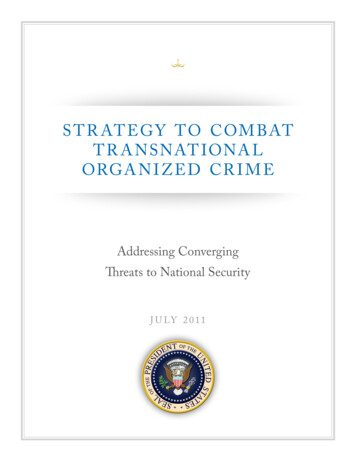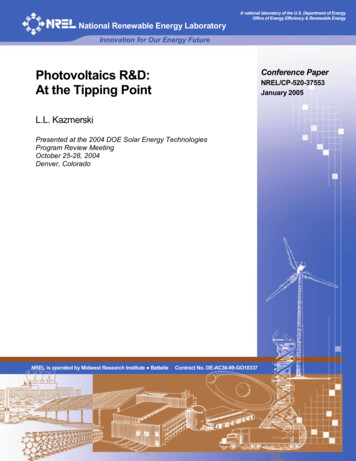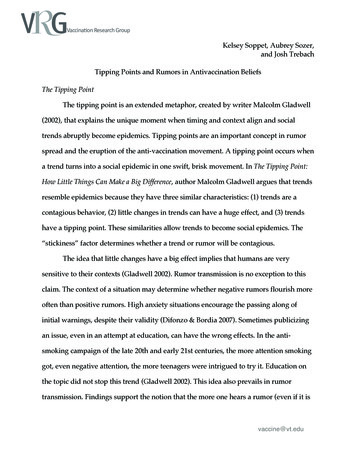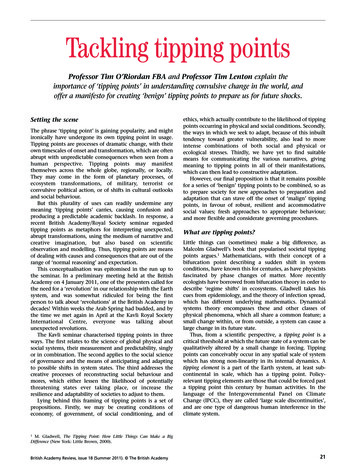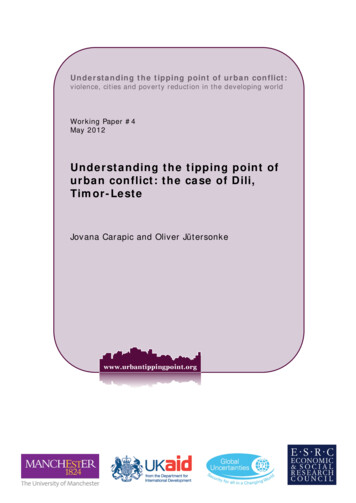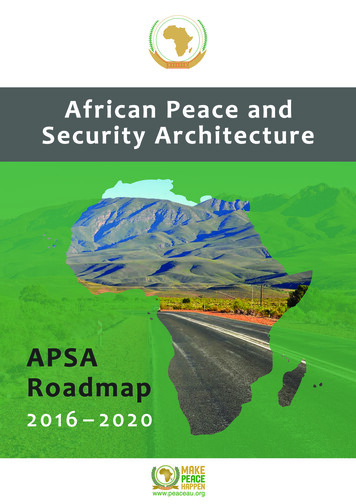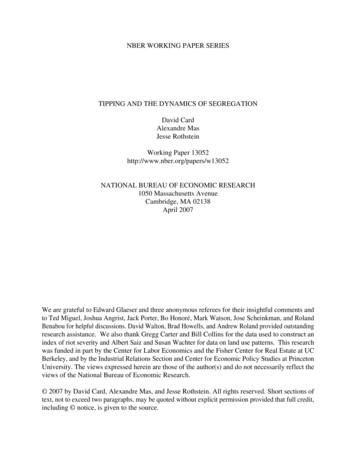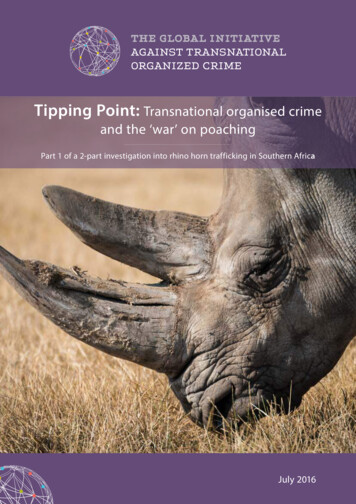
Transcription
Tipping Point: Transnational organised crimeand the ‘war’ on poachingPart 1 of a 2-part investigation into rhino horn trafficking in Southern AfricaJuly 2016
A NETWORKTO COUNTERNETWORKS
Tipping PointTransnational organised crimeand the ‘war’ on poachingPart 1 of a 2-part investigation intorhino horn trafficking in Southern AfricaBy Julian RademeyerJuly 2016
2016 Global Initiative against Transnational Organized Crime. All rights reserved.No part of this publication may be reproduced or transmitted in any form or by any means without permissionin writing from the Global Initiative. Please direct inquiries to:The Global Initiative against Transnational Organized CrimeWMO Building, 2nd Floor7bis, Avenue de la PaixCH-1211 Geneva 1Switzerlandwww.GlobalInitiative.net
AcknowledgementsThis report was written by Julian Rademeyer. Julian is an award-winning South Africaninvestigative journalist and senior research fellow with the Global Initiative AgainstTransnational Organised Crime. He is the author of the best-selling book, Killing for Profit –Exposing the illegal rhino horn trade.A report like this would not be possible without the support and invaluable contributionsof many individuals. Since I first began writing about this subject six years ago, I have beenprivileged to meet and get to know a large number of those at the forefront of local, regionaland international efforts to combat rhino poaching, disrupt the criminal networks involved and ensure the survivalof these magnificent animals. They include police, prosecutors, rangers, government officials in law enforcementand environment agencies, researchers, project managers and lobbyists at NGO’s and in the private sector, andordinary citizens. Many are exceptionally passionate, dedicated and committed despite often overwhelmingodds and – in some cases – a lack of political and institutional support for their work. I hope that this report cangive voice to some of their concerns, suggestions and observations.Phillip Hattingh, a good friend and filmmaker with a passion for rhinos, travelled many a long road with me. Iam indebted to Trish for her selfless support, encouragement and patience during the writing of these reports.Without the help and support of The Global Initiative Against Transnational Organised Crime and my colleaguesTuesday Reitano, Mark Shaw, Peter Gastrow, John M. Sellar, Annette Hübschle–Finch and Iris Oustinoff this reportcould not have been written. Willem de Klerk Attorneys provided superb legal advice. Sharon Wilson from EmergeDesign and Creative gave life to a messy Word document.The Global Initiative would like to thank the Government of Norway for their funding both in this report, and insupporting our growing emphasis and investigations on environmental crime.Special thanks are due to Richard H. Emslie and Mike Knight from the IUCN/SSC African Rhino Specialist Group,Tom Milliken from TRAFFIC, Jo Shaw from WWF-South Africa, the Endangered Wildlife Trust, SANParks, theDepartment of Environmental Affairs, the SA Police Service and the National Prosecuting Authority.I am also hugely grateful for the many people who in recent years have given of their time, endured my endlessquestions, checked my facts, served as a sounding board for ideas and provided guidance, data, advice andwhiskey. They include: Keryn Adcock, Nick Ahlers, Natasha Anderson, Simon Bloch, Peter Bowles, Kirsty Brebner,Esmond Bradley-Martin, Markus Bürgener, Thea Carroll, Rynette Coetzee, Frances Craigie, Elise Daffue, Cathy Dean,Naomi Doak, Fitzroy Drayton, Raoul du Toit, Susie Ellis, Sam Ferreira, Dominika Formanova, Yolan Friedmann,John Hanks, Pelham Jones, General Johan Jooste, Colonel Johan Jooste, Adri Kitshoff, Khadija Magardie, KenMaggs, Albi Modise, Eleanor Momberg, Alastair Nelson, David Newton, Gareth Newham, Adam Pires, PavlaŘíhová, Charles van Niekerk, Madelon Willemsen, Michael ‘t Sas-Rolfes and Allison Thomson.My thanks also to a number of those interviewed for this report who asked that their identities be protected andcannot be named. You know who you are.
Contents1. Introduction.32. South Africa.6The Republic of Kruger.7A complicated war.8War Talk.9Reluctant Militarisation.9The Poachers.11In the Line of Fire.13Weapons of War.13Regulating Silencers.14The Human Cost.15A Priority Crime.17On Our Own.18A Devastating Decision.19Starting from Scratch.19The First Strategy.20A National Wildlife Crime Reaction Unit.20NATJOINTS.21A Changing Mandate.22The Silo Effect.23The Trouble With Crime Intelligence.24Corruption.27Convictions.30The Language Barrier.32Networks Without Borders.33
Contents3. The Czech Connection - ‘White Horse’ and Pseudo Hunters.35None of Them Can Hunt.36Institutional Lapses and Corruption.38Personal Effects.39Plugging Loopholes.40The Czech Connection.41White Horses on Safari.42Allegations of a Conspiracy.43The Devil in the Detail.464. The Diamond Magnate.48The Island.515. Conclusion.56
AcronymsACUAnti-Corruption UnitAFPAgence France PresseANACNational Agency for Conservation Areas (Mozambique)ANCAfrican National CongressCASCrime Administration SystemCEICzech Environmental InspectorateCICrime IntelligenceCIOCentral Intelligence OrganisationCITESConvention on International Trade in Endangered Species of Wild Fauna and FloraCOINCounter-InsurgencyDEADepartment of Environmental AffairsDIRCODepartment of International Relations and Co-operationDPCIDirectorate for Priority Crime InvestigationDSODirectorate of Special OperationsECIEnvironmental Crime InvestigationsEIAEnvironmental Investigation AgencyEMI’sEnvironmental Management InspectorsESPUEndangered Species Protection UnitGDPGross Domestic ProductGITOCGlobal Initiative against Transnational Organized CrimeICCIntelligence Co-ordinating CommitteeICCWCInternational Consortium on Combating Wildlife CrimeIMFInternational Monetary FundIPZIntensive Protection ZoneISSInstitute for Security StudiesIUCNInternational Union for Conservation of NatureLVALayered Voice AnalysisMAManagement AuthorityMajocMission Area Joint Operations CentreMoUMemorandum of UnderstandingNAPHANamibia Professional Hunters’ Association1Global Initiative against Transnational Organized Crime Tipping Point: Transnational organised crime and the ‘war’ on poaching
NATJOINTSNational Joint Operational and Intelligence Structure)NCBNational Central BureauNEMANational Environmental Management ActNISCWTNational Integrated Strategy to Combat Wildlife TraffickingNPANational Prosecuting AuthorityNWCRUNational Wildlife Crime Reaction UnitPSOPeace Support OperationsPWAParks and Wildlife ActRhODISRhino DNA Indexing SystemSADFSouth African Defence ForceSANDFSouth African National Defence ForceSANParksSouth African National ParksSAPSSouth African Police ServiceSSAState Security AgencyTRaCCCTerrorism, Transnational Crime and Corruption CentreTRAFFICWildlife trade monitoring networkUPIUnited Press InternationalWCSWildlife Conservation SocietyWCOWorld Customs OrganisationZANU-PFZimbabwe African National Union – Patriotic Front)ZimParksZimbabwe’s Parks and Wildlife Management Authority2Global Initiative against Transnational Organized Crime Tipping Point: Transnational organised crime and the ‘war’ on poaching
Photo: Ola Jennersten / N IBL WWF1. IntroductionMore than six thousand rhinos have fallen to poachers’ bullets in Africa over the past decade.1 Dozens more havebeen shot in so-called “pseudo-hunts” in South Africa. Across Europe, castles and museums have been raided bycriminal gangs in search of rhino horn trophies. And in the United States, businessmen, antique dealers – evena former rodeo star and a university professor – have been implicated in the illicit trade. Driven by seeminglyinsatiable demand in Southeast Asia and China, rhino horn has become a black market commodity that rivalsthe value of gold and platinum.The impact of rampant poaching and deeply entrenched transnational criminal networks over the past decadehas been severe. Today there are estimated to be about 25,000 rhino left in Africa, a fraction of the tens ofthousands that existed just half-a-century ago. Numbers of white rhinos (Ceratotherium simum) have begun tostagnate and decline, with 2015 population figures estimated at between 19,666 and 21,085. While the numbersof more critically endangered black rhino (Diceros bicornis) - estimated to number between 5,040 and 5,458 –have increased, population growth rates have fallen.2Since 2008, incidents of rhino poaching have increased at a staggering rate. In 2015, 1,342 rhinos were killed for theirhorns across seven African range states, compared to just 262 in the early stages of the current crisis in 2008. Thevast majority of poaching incidents occurred in South Africa, home to about 79% of the continent’s last remainingrhinos. The country’s Kruger National Park – which contains the world’s largest rhino population – has suffered thebrunt of the slaughter. While South Africa experienced a marginal dip in poaching figures in 2015 – the first timethat the numbers had fallen since 2008 – this was offset by dramatic spikes in poaching in Namibia and Zimbabwe,two key black rhino range states. Namibia, which had experienced little to no poaching from 2006 to 2012 saw12IUCN Species Survival Commission’s African Rhino Specialist Group (AfRSG)IUCN. “IUCN Reports Deepening Rhino Poaching Crisis in Africa,” March 9, 2016. rhino-poaching-crisis-africa.3Global Initiative against Transnational Organized Crime Tipping Point: Transnational organised crime and the ‘war’ on poaching
incidents increase from four in 2013 to 30 in 2014 and 90 in 2015.3 In Zimbabwe, 51 rhinos were killed, up fromtwenty in 2014. It was the country’s worst year on record since 2008, when 164 rhinos were lost to poachers.While Vietnam remains a key destination and transit country, growing numbers of Chinese nationals have beenarrested and prosecuted in recent years in Africa, Europe, Asia and the United States for smuggling rhino horn.Research conducted by TRAFFIC has pointed to a thriving online market for rhino horn on Vietnamese andChinese social media platforms. There is some evidence of divergent markets in Vietnam and China with demandfor “raw”, unworked rhino horn in the former and carvings, libation cups and fake antiques –commonly referred toas zuo jiu – in the latter.4 In Vietnam, for instance, a number of artisanal villages are known to produce rhino hornbangles, bracelets, beads and libation cups for Chinese buyers. China has also emerged a significant destinationfor antique rhino horn carvings that have been auctioned in Europe, the United States and Australia.The killing shows little sign of slowing. Despite the valiant efforts of many law enforcementand government officials, prosecutors and game rangers, the transnational criminalnetworks trafficking rhino horn are as resilient as ever and – with rare exceptions –“Contrary toimpervious to attempts to disrupt their activities. Fragmented law enforcementpopular imagesstrategies – often led by environmental agencies with little political powerof poaching gangsand no mandate to investigate or gather intelligence on organised crimenetworks - have had little impact on syndicates that operate globally, withequipped with night sights,tentacles reaching from Africa to Europe, the United States and Asia.semi-automatic weaponsand even helicopters, mostBorders, bureaucracy and a tangle of vastly different laws and legaljurisdictions are a boon to transnational criminal networks and a bane topoachers are poorlythe law enforcement agencies rallied against them. Entities like Interpol,equipped for the bush.Europol, CITES and the World Customs Organisation are only as good asMilitary weaponsthe government officials in member states who are delegated to work withare a rarity.”them. Again and again, their efforts to target syndicates in multiple jurisdictionsare hamstrung by corruption, incompetence, governments that are unwilling orincapable of acting, a lack of information-sharing, petty jealousies and approaches totackling crime that wrongly emphasise arrests and seizures over targeted investigations and convictions as abarometer of success.Drawing on hundreds of pages of documents and extensive interviews with officials in government, conservationand law enforcement agencies in Southern Africa, Europe and Asia, this report – the first of two - examineslaw enforcement responses to international rhino horn trafficking syndicates and investigates legal loopholes,institutional lapses and a confluence of licit and illicit activities that have allow the trade to fester.The first section of this report presents an overview of law enforcement responses in South Africa since the startof the poaching crisis in the mid-2000s. The country is home to 70% of the world’s last remaining rhinos. TheKruger National Park is the eye of the storm, accounting for roughly 60% of poaching incidents over the pastseven years. It is there that a complex “war on poaching” is being waged, one that has led to the deaths of at least200 suspected poachers, several soldiers, two field rangers and a policeman.Contrary to popular images of poaching gangs equipped with night sights, semi-automatic weapons and evenhelicopters, most poachers are poorly equipped for the bush. Military weapons are a rarity, although there has34The number of rhinos poached in Namibia in 2015 was likely higher than the official tally. Thirty-four rhino carcasses were discovered inJanuary and February 2016 in the Etosha National Park and Palmwag area. They were in varying states of decay and many are believedto date from 2015. hed-rhinos-uncovered/Rademeyer, Julian. “Chinese Crime Rings and the Global Rhino Horn Trade.” China Dialogue. Accessed June 15, 2016. orn-trade.4Global Initiative against Transnational Organized Crime Tipping Point: Transnational organised crime and the ‘war’ on poaching
been an influx in recent years of increasingly sophisticated .375 and .458 calibre hunting rifles equipped withsilencers. At any time, more than a dozen poaching gangs are operating in the park, sometimes saturating areaswhere large numbers of rhino are found. It is a dangerous work, but for those prepared to take the risks therewards can be high with poachers receiving payments ranging from as little as 2000 to as much as 20,000.In 2015 it is estimated that at least 7,500 poachers entered the park, a 43% increase on the previous year.Against seemingly improbable odds, rangers managed to hold the line, preventing another significant spike inpoaching numbers.The closure of the police’s Endangered Species Protection Unit in the early 2000s, widespread maladministration,corruption and political meddling in the South African Police Service and its Crime Intelligence division andpervasive ill-discipline in the South African National Defence Force have had a severely detrimental effect onefforts to curb poaching.Until fairly recently, law enforcement responses in South Africa have largely been driven by the country’sDepartment of Environmental Affairs (DEA) and conservation agencies with limited support from police andsecurity agencies. The Department has also taken the lead in negotiating co-operation agreements with theircounterparts in Vietnam, China, Mozambique and Cambodia. But many of those interviewed for this report arguethat the “wrong people are sitting around the table” and that environmental ministries, which are regarded asrelatively junior entities in the governments concerned do not have the power or mandate to influence lawenforcement and national security strategies. As a result, previous efforts by the Department to establisha National Wildlife Crime Reaction Unit failed to gain traction. Increasingly, the responsibility for tackling thetransnational criminal networks involved in rhino poaching is being shifted to security ministries and police. Anew National Integrated Strategy to Combat Wildlife Trafficking has been developed for police and proposesa centralised structure to co-ordinate investigations and responses. Completed in February 2016, it has thepotential – if implemented correctly – to have a positive impact.The second section of the report examines the confluence of licit and illicit activities in the trade in rhino hornsand sheds new light on investigations in Europe into so-called pseudo-hunting cases, and the links betweensyndicates smuggling rhino horn in the Czech Republic and other countries to crimes that include the trade incounterfeit goods and the drug smuggling. It also presents evidence of the involvement of Vietnamese pseudohunters and rhino horn smugglers in a tiger and rhino farm in South Africa’s North West province and theirinvolvement in attempting to secure a hundred rhinos for a new safari park established in Vietnam by one of thecountry’s largest companies.5Global Initiative against Transnational Organized Crime Tipping Point: Transnational organised crime and the ‘war’ on poaching
2. South AfricaSouth Africa is home to more than 70% of the world’s last remaining wild rhinos and 79% of Africa’s: an estimated18,413 white rhino and 1,893 black rhino.5 It is one of the country’s greatest conservation success stories and onethat is dangerously close to coming undone.Figure 1: Map of Kruger national rugerNationalParkPretoriaMaputoSouth AfricaSwazilandFrom January 2006 to April 2016, at least 5,460 rhino were killed in South Africa, accounting for about 84% ofAfrica’s total rhino poaching losses.6 7 With the exception of 2015 - which saw a marginal drop in numbers, offsetby a dramatic increase in poaching in neighbouring Namibia and Zimbabwe – a grim new record has been setevery year. Over the past decade, South Africa has lost twenty-two times the number of rhinos that it lost topoaching in the preceding 25 years.8Figure 2: Reported rhino poaching incidents in South Africa (2000-2015)121511751004668448333762000 200156782520022210132413831222003 2004 2005 2006 2007 2008 2009 2010 2011 2012 2013 2014 2015IUCN Species Survival Commission’s African Rhino Specialist Group (AfRSG)Department of Environmental Affairs poaching statistics for 2006 - 2015IUCN Species Survival Commission’s African Rhino Specialist GroupWalker, Clive, and Anton Walker. The Rhino Keepers: Struggle for Survival. Sunnyside, Auckland Park 2092, South Africa: Jacana Media, 2012.6Global Initiative against Transnational Organized Crime Tipping Point: Transnational organised crime and the ‘war’ on poaching
The ‘Republic of Kruger’South Africa’s Kruger National Park is the eye of the storm, accounting for roughly 60% of poaching incidents overthe past seven years. It holds a population of around 8,875 southern white rhino and 384 south-eastern blackrhino; approximately 48.2%% and 7.3% of the world’s white and black rhinos respectively.9 Most are clustered inan “Intensive Protection Zone (IPZ)” in the south of the park.Figure 3: Rhino population percentages and numbers of poaching deaths in Africa2.5%NUMBER OF POACHED RHINOS*OTHER AFRICAN RANGE STATES20122220131620149201512Other AfricanRange States4.4%NUMBER OF POACHED R OF POACHED 51NUMBER OF POACHED OUTH AFRICANUMBER OF POACHED ercentage of African rhinos per range state.Source: IUCN SSC AfRSGThe park has lost more than 3,189 rhinos to poachers in the past decade and the population now appears tobe declining. According to the IUCN Species Survival Commission’s African Rhino Specialist Group, “statisticalmodelling suggests that in all likelihood the populations of both black and white rhinos have decreased” since2012.10 A recent academic paper suggests that if poaching rates continue at levels experienced in 2013 (when598 rhinos were reported killed), the Kruger National Park’s white rhino population will “plummet to [between]910Email correspondence with Richard Emslie, IUCN AfRSG Scientific OfficerIUCN. “IUCN Reports Deepening Rhino Poaching Crisis in Africa,” March 9, 2016. rhino-poaching-crisis-africa.7Global Initiative against Transnational Organized Crime Tipping Point: Transnational organised crime and the ‘war’ on poaching
2879 and 3263 individuals by 2018”, about a third of current population estimates.11 Given that the park lost 826rhinos to poachers last year, three fewer than in 2014, estimates based on 2013 rates are conservative.Nearly 80% of poaching activity in recent years has been concentrated on the south of the park. In 2015, officialsrecorded a 43% increase in poacher activity in the park compared to the previous year. There were approximately2,466 “incursions” – evidenced by fresh spoor, shots heard and poacher sightings - and 137 armed “contacts”between poachers and rangers, compared to 111 “contacts” in 2014, and 202 arrests. Kruger National Park officials“conservatively estimate” that at least 7,500 poachers entered the park in 2015, compared to 4,300 in 2014. Therewere an estimated 1,038 incursions in the first four months of 2016, compared to 808 in the same period in 2015.Despite this, according to official statistics, the park lost 826 rhino in 2015 – three fewer than the previous year –and 232 in the first four months of 2016, compared to 302 over the same period in 2015.12 13Figure 4: Recorded monthly rhino poaching figures, Kruger National Park (2013-15)1201131009288808277716760514059565549 0January FebruaryMarchAprilMayJune2013JulyAugust September October November December20142015Source: South African Police ServiceA Complicated WarOn the frontlines of the Kruger National Park’s “war on poaching” are around 400 field rangers, 22 section rangersand 15 special rangers.14 This equates to roughly one ranger for every 47 km2. But that would only be the case ifthey worked 24 hours a day, seven days a week. In reality, less than half that number are deployed at any giventime. They are supported by a dozen investigators, four helicopter pilots, a fixed-wing pilot and three Bantammicrolight pilots.The park – roughly the same size as Israel or Wales - covers an area of 19,485 square kilometres. Park officialsoften dryly refer to it as the “Republic of Kruger”. Driving along the tourist roads and dirt tracks that loop throughdense bush past waterholes teeming with wildlife, it is difficult to comprehend the sheer expanse of the terrain.“To bring it home to people, I fly them to a rhino carcass. Then we get back into a helicopter and climb to 1,500feet or 2,000 feet. The horizon gets rounder and the sky darkens and you see the vastness,” says head ranger Ken11121314Ferreira, SM, Greaver, C, Knight, GA, Knight, MH, Smit, IPJ, and Pienaar, D. “Disruption of Rhino Demography by Poachers May Lead toPopulation Declines in Kruger National Park, South Africa.” PLoS ONE 10(6): e0127783. doi:10.1371/journal. pone.0127783 (2015). http://journals.plos.org/plosone/article?id 10.1371/journal.pone.0127783.Source: SANParksDepartment of Environmental Affairs. “Minister Edna Molewa Joined by Security Cluster Ministers Highlights Progress in the Fightagainst Rhino Poaching,” May 8, 2016. https://www.environment.gov.za/mediarelease/molewa onprogresagainst rhinopoaching.Major-General Johan Jooste. “Media Briefing on Rhino Poaching in the Kruger National Park.” August 30, 2015.8Global Initiative against Transnational Organized Crime Tipping Point: Transnational organised crime and the ‘war’ on poaching
Maggs. “The carcass below and the people around the crime scene become pinpricks and then vanish into thebush as you climb. There are no witnesses around, not a house in sight where you can question anyone. You’rerelying on spoor left by the poachers and any other physical evidence that you can find.”15War TalkAs the numbers of poaching incidents and incursions have increased, so has the militarised response. In December2012, SANParks appointed a retired army major-general, Johan Jooste, as head of “Special Projects”. A 35-yearveteran of the South African Defence Force (SADF) and its post-1994 incarnation, the South African NationalDefence Force (SANDF), Jooste was tasked with developing and implementing an anti-poaching strategy inthe Kruger. “Our approach was quite fragmented at the time,” says Maggs, who has worked in the park for morethan twenty years, at various times heading up anti-poaching teams and managing the SANParks EnvironmentalCrime Investigations (ECI) unit. “[Jooste] brought his knowledge, experience and strategic thinking. He adaptedmilitary doctrine that could be applied practically in our situation.”In his first statement after his appointment, Jooste did not mince words: “The battle lines have been drawn and itis up to my team and me to forcefully push back the frontiers of poaching.
Global Initiative against Transnational Organized Crime Tipping Point: Transnational organised crime and the 'war' on poaching incidents increase from four in 2013 to 30 in 2014 and 90 in 2015.3 In Zimbabwe, 51 rhinos were killed, up from twenty in 2014. It was the country's worst year on record since 2008, when 164 rhinos were lost to .
